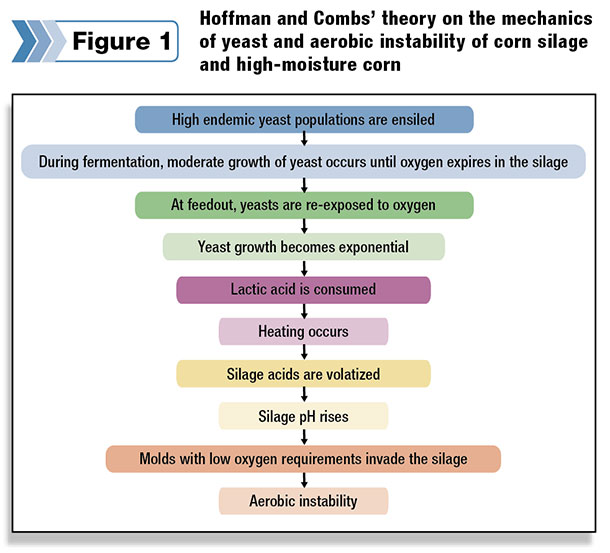In my former life as a practicing veterinarian and nutritionist, I remember when the questions from producers used to be simple: “Why should I use inoculants?” or “If I use them, will I actually have better silage?” Nowadays, there is plenty of third-party research backing up the efficacy claims of inoculants. Now the questions from producers have shifted from “Should I use inoculants?” to “Which inoculant is the best for my crops?” Other questions like, “What’s in an inoculant?” and “Does bacteria type matter?” dig even deeper.
Most inoculants contain either a heterofermentative or homofermentative lactic acid bacteria (LAB). In this article, I’ll try to explain their differences, especially when it comes to silage quality and stability, dry matter loss and milk production.
The background on bacteria
LAB are micro-organisms that have been used for centuries to prepare and improve storage of food, and for ensiling different crops for animal feed. Egyptian murals dating from 1500 BC demonstrate storage of crops in silos.
Nowadays, fermentation is performed by the deliberate addition of LAB as starter cultures to the material to be preserved. This results in a high degree of control over the fermentation process and better quality of the end product.
Advancements in technology
In the ’90s, some attributes of inoculants were established that would improve the fermentation process:
• Fast growth and ability to compete with other micro-organisms in the crop
• Homofermentative – generating rapid production of lactic acid
• Able to produce a final pH of at least 4 as rapidly as possible
• Growth or survival at temperatures up to 122ºF
• Suitable and stable as a dry formulation (e.g., by freeze drying)
Then someone said, “It’s not enough.” A good inoculant should be able to make the fermentation process more efficient by decreasing dry matter losses and making the nutrients more digestible.
Also, those inoculants need to aid the aerobic stability of silage and improve animal performance. (At this point, I hope I’ve helped you realize the life of inoculant bacteria isn’t easy.)
Importance of aerobic stability
This is an important step since unstable feeds can have negative impact on animal health and performance.
Yeasts and molds are the major culprits associated with aerobic instability of corn silage and high-moisture corn. If there is oxygen, yeast will degrade the lactic acid in the silage, turning it into carbon dioxide and water.
This process increases the pH of the silage to a level that allows opportunistic bacteria and molds to grow. This can happen during the fermentation process or at feedout ( Figure 1 ).

This aerobic instability is undesirable because it elicits the loss of nutrients, which can lower animal performance.
In a study by Patrick Hoffman and David Combs of the University of Wisconsin – Madison, using unstable high-moisture corn in a cow’s diet concluded that the milk production losses were not related to yeast populations but due to the metabolism of the lactic acid and volatilization of other organic acids by those yeast.
This reduced the energy content of the high-moisture corn, resulting in the chronic loss of milk production.
Controlling yeasts and molds with LAB
The first commercial success using LAB to control molds and yeast was with Lactobacillus buchneri . This heterofermentative LAB produces acetic acid, which inhibits the growth of yeasts and molds. The downside of acetic acid is related to dry matter loss.
There is no dry matter loss when lactic acid bacteria ferment sugar, creating lactic acid. In contrast, fermentation that produces lactic acid plus alcohol, or acetic acid, results in up to a 24 percent loss of the original sugar – a significant dry matter loss when compared with homofermentative LAB and non-inoculated silages.
Some strains of Lactobacillus plantarum , a homofermentative LAB, were found to have an effect on secondary fermentation. For instance, L. plantarum MILAB 393 secretes a bacteriocin and other metabolites during the fermentation that has an inhibitory effect on certain types of yeasts and molds.
So when oxygen is reintroduced into the silo, the yeast’s ability to proliferate has been greatly reduced. Since yeasts are the primary cause of heating, reducing yeast populations will reduce secondary heating and prevent dry matter loss.
Another point favoring homofermentative LAB is evidence that cows consuming silage inoculated with this type of bacteria produce more milk.
The Forage Research Center indicates that homofermentative LAB silage inoculants increase animal performance by 3 to 5 percent, but the same results were not seen in the heterolactic fermentors, like L. buchneri.
There is no loss of energy from lactic acid at any point in the process of digestion, absorption or metabolism. Additionally, the homofermentative LAB works to reduce the pH and protein degradation during the ensiling process.
Conclusion
Homofermentative inoculants do not produce CO2 and therefore improve dry matter recovery from the silo when compared to untreated silage or feed treated with heterofermentative inoculants.
Also, homofermentation drops the pH fast, inhibiting other organisms from growing and helps preserve protein and energy of feed, which may explain the possible increase in milk production.
No matter what inoculant you chose, good practices such as harvesting at proper moisture contents, rapid filling, plastic covers, and extensive packing are all necessary to have good silage. PD
—With contributions from Jim Mattox, solution manager, Feedtech

Edmar Freitas
Product Specialist
Nutrition in the Americas






